NavSource Online: Submarine Photo Archive
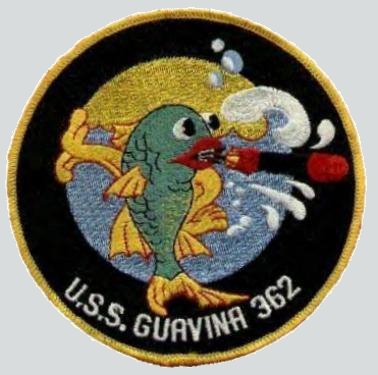
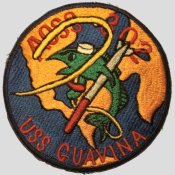
Patches contributed by Mike Smolinski
Please report any broken links or trouble you might come across to the Webmaster.
Please take a moment to let us know so that we can correct any problems and make your visit as enjoyable and as informative as possible.


| Click On Image For Full Size | Size | Image Description | Source | |
|---|---|---|---|---|
 |
329k | Philypnus dormitor (Lacepede) Guavina. | Image from page 728 of "Fishes" (1907), courtesy of flickr.com. | |
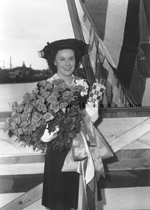 0836236 | 363k | Marie Roen, sponsor of the Manitowoc built submarine Guavina (SS-362) at Manitowoc Shipbuilding Company on 29 August 1943. | Photo by Harry Berns, Official photographer of the Manitowoc Shipbuilding Co., Manitowoc, WI. This photo # P-707290, can be ordered from the Wisconsin Maritime Museum. |
|
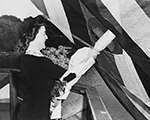 |
424k | The Guavina (SS-362) was sponsored by Miss Marie Roen. | USN photo courtesy of Scott Koen & ussnewyork.com. | |
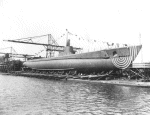 | 48k | Guavina (SS-362), on the building ways at Manitowoc Shipbuilding Co., Manitowoc, WI., 29 August 1943. | Editors Note: There are over 200 images submitted on these pages covering the following submarines that were constructed at the Manitowoc Shipbuilding Co, Manitowoc, WI,: SS-265 through SS-274, and SS-361 through SS-380. None of them would have seen the light of day if it were not for the efforts of Curator, Asst. Director, Bill Thiesen of the Wisconsin Maritime Museum and Larry Bohn, who sent them to NavSource for publication. A special debt of gratitude is owed to these two men and the Wisconsin Maritime Museum, home of the Cobia (SS-245), for allowing these photographs to be seen by the lovers of naval history worldwide. | |
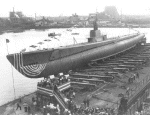 | 48k | The Guavina (SS-362) starts to raise her launching timbers on the building ways at Manitowoc Shipbuilding Co., Manitowoc, WI., 29 August 1943. | Photo by Harry Berns, Official photographer of the Manitowoc Shipbuilding Co., Manitowoc, WI. Submitted by Larry Bohn. Courtesy of the Wisconsin Maritime Museum, home of the Cobia (SS-245) |
|
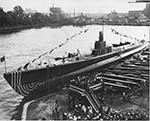 |
570k | Waterborne Guavina (SS-362). | USN photo # 80-G-212980, from National Archives and Records Administration (NARA), College Park, Maryland, courtesy of Sean Hert. | |
 | 33k | Commemorative postal cover marking the Guavina's (SS-362) launching on 29 August 1943. | Courtesy of petloveshack.com. | |
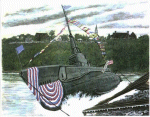 | 55k | Watercolor print by the artist Tom Denton of the side launching of a Manitowoc built boat. | Courtesy of submarineart.com. | |
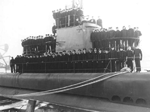 | 115k | Plankowners of the Guavina (SS-362) pose on the building ways at Manitowoc Shipbuilding Co., Manitowoc, WI., 29 August 1943. | Photo by Harry Berns, Official photographer of the Manitowoc Shipbuilding Co., Manitowoc, WI. Submitted by Larry Bohn, courtesy of the Wisconsin Maritime Museum, home of the Cobia (SS-245) |
|
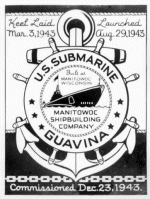 | 38k | Guavina (SS-362) commissioning emblem, 23 December 1943. | Photo by Harry Berns, Official photographer of the Manitowoc Shipbuilding Co., Manitowoc, WI. Submitted by Larry Bohn, courtesy of the Wisconsin Maritime Museum, home of the Cobia (SS-245) |
|
 | 174k | Guavina (SS-362), underway in the Pacific, circa 1944-45. | Courtesy of ussubvetsofwwii.org. | |
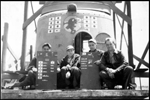 0836224 | 229k | Four crew members holding scoreboards on Guavina (SS-362). Note the battle insignia and scoreboard of enemy vessels destroyed painted on forward Conning Tower. Pictured left to right: Max Clayton Baxter, Darris Ellis Province, LaVergne C. Ward, and Dennis Leroy Erickson. | Photo courtesy of htrnews.com via Robert Morgan. | |
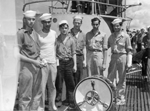 0836204 | 436k | Los Negros, Admiralty Islands - Six gunners from two 13th AAF Consolidated B-24 "Liberators" of the 394th Bomb Squadron, 5th Bomb Group, shot down over Yap Island in the Caroline Group, pose aboard the submarine that rescued them. Wearing Navy clothes given them by the men aboard the sub, they are, left to right; S/Sgt. Richard Morrison, Ione, Washington; T/Sgt. Peter J. Ferrand, Chicago, Illinois; S/Sgt Charles E. Craighead, Jr., Roanoke, Virginia; T/Sgt. Lonnie M. James, Carlin, Nevada; Cpl. George Christopolis, Long Island, New York and S/Sgt. John J. Morrison, Evanston, Illinois." 25 July 1944. Seeadler Harbor, Manus Island, Admiralty Islands. Crew member of B-24 bomber #44-40609 rescued by SS-362 on 14 July 1944. Richard Morrison. Crew of B-24J bomber #42-73197 rescued by SS-362 on 19 July 1944: Ferrand, Craighead, James, Christopolis & J. J. Morrison. SS-363 Pharmacist Mate dressed all wounds and administered brandy. | Ref. U.S. Submarine War Patrol Reports, Guavina (SS-362), June 1944-July 1944; 394th Bombardment Squadron Missing Air Crew Reports, MACR #9580 and #10653,] Dept. of the Air Force Photo. U.S. Air Force Number 3A31449. National Archives ID 204952852. Local ID 342-FH-3A31449-3A31449, courtesy of David Upton. |
|
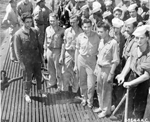 0836237 | 715k | Los Negros, Admiralty Islands - Surviving officers of the two 13th AAF Consolidated B-24 "Liberators" from the 394th Bomb Squadron, 5th Bomb Group, shot down over Yap Island in the Caroline Group, pose with the crew of the submarine that rescued them. They are, left to right; 1st Lt. Phillip Hickey, Youngstown, Ohio; Capt. Robert N. McConnell, Chicago, Illinois; Capt. Dick R. Longino, Jr., Atlanta, Georgia; Flight Officer William L. Merrill, Monmouth, Illinois and 2nd Lt. Douglas J. Vaughn, Oakland, California. [Taken 25 July 1944. Seeadler Harbor, Manus Island, Admiralty Islands. Officers of B-24 bomber #44-40609 rescued by SS-362 on 14 July 1944. Merrill, Vaughn. Officers of B-24J bomber #42-73197 rescued by SS-362 on 19 July 1944. | Ref. U.S. Submarine War Patrol Reports, Guavina (SS-362), June 1944-July 1944; 394th Bombardment Squadron Missing Air Crew Reports, MACR #9580 and #10653,] Dept. of the Air Force Photo. U.S. Air Force Number 68144AC; National Archives ID 204952872. Local ID 342-FH-3A31456-68144AC courtesy of David Upton. | |
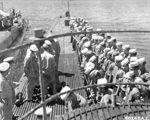 0836238 | 1.01k | Los Negros, Admiralty Islands - The crew of the submarine which rescued flyers of two 13th AAF bombers from the 394th Bomb Squadron, 5th Bomb Group shot down over Yap Island in the Caroline Group, line up to hear a note of thanks from Colonel A. H. Luehman, member of Major General St. Clair Streett's staff. Buddies of the rescued men prepared a heart-felt and artistically designed scroll to be presented to the submarine skipper, Lt. Commander Carl Tiedeman of Sioux City, Iowa, as a token of their appreciation for the life-saving work the sub had done." [Taken 25 July 1944. Seeadler Harbor, Manus Island, Admiralty Islands. Submarine stern to starboard of the Guavina (SS-362) belongs to Bashaw (SS-241). "Colonel A. H. Luehman, U.S.A. came aboard with ComSubRon 18, to received the "Army Aviators" onboard, and delivered a "Commendation" from Commander Thirteenth Air Force, U.S.A. to the C.C., officers, and crew of Guavina relative to rescue." | Ref. U.S. Submarine War Patrol Reports, Guavina, June 1944-July 1944; 394th Bombardment Squadron Missing Air Crew Reports, MACR #9580 and #10653,] Dept. of the Air Force Photo. U.S. Air Force Number 68144AC; National Archives ID 204952872. Local ID 342-FH-3A31456-68144AC courtesy of David Upton. | |
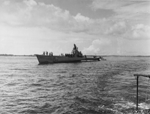 0836239 | 1.09k | The submarine, Guavina (SS-362), carrying the rescued flyers of the 394th Bomb Squadron, 5th Bomb Group, who were shot down over enemy targets, comes into Seeadler Harbor, Los Negros, Admiralty Islands." Photo taken 25 July 1944, Seeadler Harbor, Manus Island, Admiralty Islands. Photo taken from escort YMS-49. | Ref. U.S. Submarine War Patrol Reports, Guavina, June 1944-July 1944; 394th Bombardment Squadron Missing Air Crew Reports, MACR #9580 and #10653,] Dept. of the Air Force Photo. U.S. Air Force Number 68144AC; National Archives ID 204952872. Local ID 342-FH-3A31456-68144AC courtesy of David Upton. | |
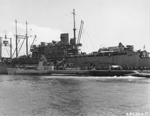 0836235 | 1.01k | The submarine, Guavina (SS-362), comes alongside a mother ship in Seeadler Harbor, Los Negros, Admiralty Islands, carrying the rescued flyers of the 394th Bomb Squadron, 5th Bomb Group, who were shot down while on a mission over Yap Island in the Caroline Islands." Outboard- Guavina Inboard-Bashaw (SS-241) (Arrived alongside Euryale (AS-22) 17-30 July for bridge remodel. Left 7 August 44. ref. Bashaw War Patrol report August 1944). [Taken 25 July 1944. Seeadler Harbor, Manus Island, Admiralty Islands. Photo taken from escort YMS-49. Tender- Euryale. | Ref. U.S. Submarine War Patrol Reports, Guavina, June 1944-July 1944 and Bashaw August 1944, and Euryale War Diary July 1944.] courtesy of David Upton. | |
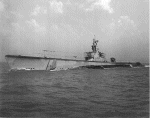 | 150k | Major overhaul of the Guavina (SS-362) at the Bethlehem Steel Shipyard in San Francisco during the summer of 1945. It is distinguishable by the new 5 inch deck gun mounted aft of the conning tower shears. | Courtesy of Robert E. Straub, RM2,SS, Guavina (August 1944 to August 1946). | |
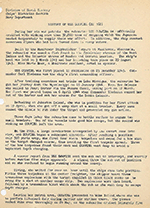 |
424k | 56 page PDF history & WW II patrols of the Guavina (SS-362). | USN photos courtesy of Scott Koen & ussnewyork.com. | |
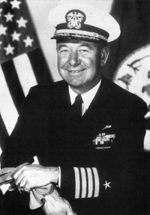 |
155k | Lt. Commander Ralph Huntington Lockwood served as executive officer and later commanding officer of the submarine Guavina (SS-362) from August, 1943 to December, 1945. For duty on board Guavina, he was awarded two Silver Stars and a Second Bronze Star. Included here is a PDF of Guavina's decommissioning Public Information Package prepared by her XO, LCDR J. T. Garrow. The package includes the following; war patrol summary, Awards, Citations, Honors received by crew members during her WWII service and 29 August 1945 crew listing. |
Image from the San Diego Navy Historical Association courtesy of Bill Gonyo. PDF courtesy of Darryl L. Baker. |
|
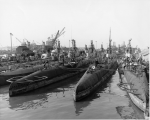 |
461k | 6 December 1945 photo appeared in the 14 December 45 issue of the Mare Island newspaper lists the following subs present at the dockyard: Unknown, Dragonet (SS-293), Guavina (SS-362), Sunfish (SS-281), Sargo (SS-188), Spearfish (SS-190), Saury (SS-189). First two ships in second row appear to be: Bashaw (SS-241) and Mingo (SS-261). The Tiru (SS-416) is on the building ways on the left above the subs and surrounding by staging and cranes. It is interesting to note that the boats have started the mothballing process, as evidenced by the preservative cocoons around the deck guns. |
USN photo courtesy of Darryl L. Baker. Partial text courtesy of David Johnston, USNR. |
|
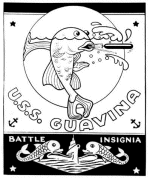 | 43k | Guavina's (SS-362) battle insignia. | Photo by Harry Berns, Official photographer of the Manitowoc Shipbuilding Co., Manitowoc, WI. Submitted by Larry Bohn, courtesy of the Wisconsin Maritime Museum, home of the Cobia (SS-245) |
|
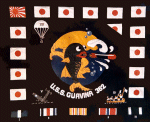 | 97k | Guavina (SS-362) WW II battleflag. | Courtesy of ussubvetsofwwii.org. | |
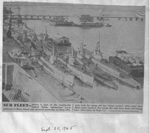 |
1.18k | The table below lists the location of submarines at Mare Island on 20 September 1945. This information was pulled from microfiche copies of the hand written shipyard journals. I'm surprised that both the clipping and my table show 21 subs at the yard on the date in question. The photo is looking north and berth 3 is at the top of the photo and then the berths run down or south. Berth 3 - Springer (SS-414) & Spadefish (SS-411) Berth 4 - Guavina (SS-362) & Barbero (SS-317) Berth 5 - Hammerhead (SS-364), Tinosa (SS-283), Mapiro (SS-376) & Moray (SS-300) Berth 6 - Bream (SS-243), Seahorse (SS-304), Batfish (SS-310) & Aspro (SS-309) Berth 7 - Pomfret (SS-391), Parche (SS-384) & Sunfish (SS-281) Berth 8 - Queenfish (SS-393) Berth 9 - Lionfish (SS-298) & Plaice (SS-390) Dry Dock 1 - Bashaw (SS-241) & Mingo (SS-261) Berth 12 - Guitarro (SS-363). |
Photo i.d. & text courtesy of Darryl L. Baker. Photo courtesy of Ron Reeves (of blessed memory). | |
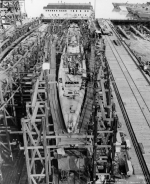 |
308k | Bow view of the Tiru (SS-416) under construction at Mare Island on 3 January 1946. Submarines in the background are decommissioned or will soon be: from front to rear are Bashaw (SS-241), Pampanito (SS-383), Mingo (SS-261), Gurnard (SS-254), Macabi (SS-375), Tunny (SS-282), Guavina (SS-362) and Sand Lance (SS-381). | USN photo # 18-46, courtesy of Darryl L. Baker. | |
 | 137k | Reserve fleet at Mare Island, circa January 1946. There are 52 submarines and 4 Sub Tenders in this photo. This photo is a Berthing list identifying the ships in the picture. | Photo commemorating 50 years, U. S. Submarine Veterans of WW II 1996 calendar, courtesy of Darryl L. Baker. | |
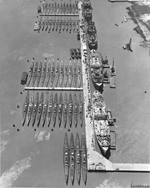 | 453k | Photo of the Reserve fleet at Mare Island, circa January 1946. There are 52 submarines and 4 Sub Tenders in this photo. Whether coincidental or on purpose, the number of boats in the photo is the same as that which were lost in WW II. From back to front and left to right, first group of 12 boats: Sand Lance (SS-381) Tunny (SS-282) Aspro (SS-309) Lionfish (SS-298) Guvania (SS-362) Sunfish (SS-281) Macabi (SS-375) Gurnard (SS-254) Pampanito (SS-383) Mingo (SS-261) Guitarro (SS-363) Bashaw (SS-241) From back to front and left to right, second group of 12 boats: Sealion (SS-315) Hammerhead (SS-364) Bream (SS-243) Seahorse (SS-304) Tinosa (SS-283) Pintado (SS-387) Mapiro (SS-376) Pipefish (SS-388) Moray (SS-300) Batfish (SS-310) Hackleback (SS-295) Bluegill (SS-242) From back to front and left to right, third group of 12 boats: Hawkbill (SS-366) Menhaden (SS-377) Perch (SS-313) Loggerhead (SS-374) Barbero (SS-317) Baya (SS-318) Hardhead (SS-365) Spadefish (SS-411) Springer (SS-414) Devilfish (SS-292) Kraken (SS-370) Dragonet (SS-293) From back to front and left to right, fourth group of 12 boats: Lamprey (SS-372) Piranha (SS-389) Manta (SS-299) Pargo (SS-264) Rancador (SS-301) Archerfish (SS-311) Mero (SS-378) Sawfish (SS-276) Spot (SS-413) Lizardfish (SS-373) Jallao (SS-368) Icefish (SS-367) From back to front and left to right, last group of 4 boats: Steelhead (SS-280) Puffer (SS-268) Stickleback (SS-415) Trepang (SS-412) From back to front, Submarine Tenders group of 4 ships: Pelias (AS-14) Aegir (AS-23) Euryale (AS-22) Griffin (AS-13) | Photo commemorating 50 years, U. S. Submarine Veterans of WW II 1996 calendar, courtesy of Darryl L. Baker. | |
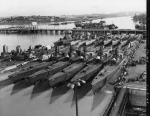 |
900k | Inactivated submarines at Mare Island on 3 January 1946. Front row left to right: Sand Lance (SS-381), next two could be Sealion (SS-315) and Seahorse (SS-304), Searaven (SS-196), Pampanito (SS-383), Gurnard (SS-254), Mingo (SS-261), Guitarro (SS-363), Bashaw (SS-241). Back row left to right: Unknown, Tunny (SS-282), next three could be Sargo (SS-188), Spearfish (SS-190), and Saury (SS-189), Macabi (SS-375), Sunfish (SS-281), Guavina (SS-362), Lionfish (SS-298),Piranha (SS-389). The Scabbardfish (SS-397) is docked in ARD-11 on the other side of the causeway. The mixture of boats from the Salmon/Sargo, Gato, and Balao classes illustrate the clear differences in the conning tower fairwaters and the periscope shears that can be used to identify boats. The high bridges with the uncovered support frames (the "covered wagon" look) of the Gato's and Salmon/Sargo's contrast with the low and sleek look of the Balao's. The fatter, more robust periscope shears of the Balao's are markedly different from the thinner shears with more supporting structure of the Gato's and Salmon/Sargo's . The differences in the pattern of the superstructure limber holes can also be used for identification purposes. The single row of large semi-circular holes identify Electric Boat or Manitowoc boats. A dual row of smaller rectangular holes mark the government built boats. Also note that the EB/Manitowoc boats have the deck mounted, T-shaped JP sonar head on the starboard side of the forward deck, while the government boats have it on the port side. EB/Manitowoc boats had the anchor on the starboard side, the government boats on the port side. A close look will show that some of the boats have had the anchor removed and the hawsepipe plated over as part of the mothball process. Most of the boats have the late war radar outfit of the SJ surface search (small dish) and SV air search (large dish). The Balao's and some of the Gato's have the SS dish mounted on a separate large mast aft of the periscopes. The older Salmon/Sargo's and Gato's have a much smaller mast. Searaven appears to have had her radars already removed. Searaven is actually sporting a late war SJ surface search antennae mounted to starboard of the periscopes. This is a rare installation. Most often it was mounted forward (early war) or aft (late war) of the 'scopes shears. Her air search set is a late war SD antennae mounted on a stub mast directly aft of the 'scopes. Searaven never received the much more capable SV air search set. Having been assigned to training duties after November, 1944 it was probably felt that the SV set was not necessary. One strange thing: almost all of the boats appear to have the outer doors of the forward torpedo tubes open. Even though the boats have an interlock system that prevents the breech and outer doors from being opened at the same time, this is an unusual thing to do and a potential source of catastrophic flooding. |
USN photo # 17-46, courtesy of Darryl L. Baker. Text courtesy of David Johnston |
|
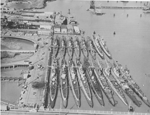 | 289k | Inactivated submarines at Mare Island in early 1946. Front row left to right: Sand Lance (SS-381), next two could be Sealion (SS-315) and Seahorse (SS-304), Searaven (SS-196), Pampanito (SS-383), Gurnard (SS-254), Mingo (SS-261), Guitarro (SS-363), Bashaw (SS-241). Back row left to right: Unknown, Tunny (SS-282), next three could be Sargo (SS-188), Spearfish (SS-190), and Saury (SS-189), Macabi (SS-375), Sunfish (SS-281), Guavina (SS-362), Lionfish (SS-298),Piranha (SS-389). The Scabbardfish (SS-397) is docked in ARD-11 on the other side of the causeway. Tiru (SS-416) is on the ways in upper left hand side of photo. Two ferry boats (to the right of Tiru's ways) are YHB-2 / [ex-Post of Stockton] and YHB-21 / [ex-Tamalpais]. | Photo i.d. courtesy of Darryl L. Baker. USN photo courtesy of Scott Koen & ussnewyork.com. |
|
 | 333k | Guavina (SS-362) oiler conversion plan. | USN photo courtesy of Scott Koen & ussnewyork.com. | |
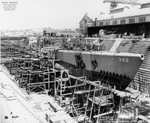 | 530k | Bow view of Guavina (SS-362) in Mare Island's dry dock #1 during her conversion to submarine tanker on 20 June 1949. | USN photo # 3810-6-49, courtesy of Darryl L. Baker. | |
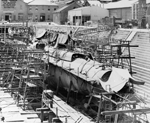 | 551k | Stern view of Guavina (SS-362) in Mare Island's dry dock #1 during her conversion to submarine tanker on 20 June 1949. | USN photo # 3811-6-49, courtesy of Darryl L. Baker. | |
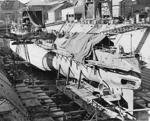 | 474k | Stern view of Guavina (SS-362) in Mare Island's dry dock #1 during her conversion to submarine tanker 18 November 1949. | USN photo # 4884-11-49, courtesy of Darryl L. Baker. | |
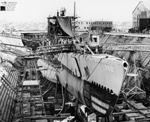 | 474k | Bow view of Guavina (SS-362) in Mare Island's dry dock #1 during her conversion to submarine tanker 18 November 1949. | USN photo # 4885-11-49, courtesy of Darryl L. Baker. | |
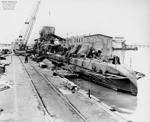 | 437k | Stern view of Guavina (SS-362) at her outfitting berth during her conversion at Mare Island on 20 January 1950. | USN photo # 5274-1-50, courtesy of Darryl L. Baker. | |
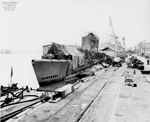 | 328k | Bow view of Guavina (SS-362) at her outfitting berth during her conversion at Mare Island on 20 January 1950. | USN photo # 5275-1-50, courtesy of Darryl L. Baker. | |
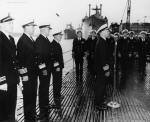 | 124k | Commissioning ceremonies aboard Guavina (AOSS-362) at Mare Island on 1 February 1950. Officer from left to right: Unidentified LCDR, Capt. R. E. Bacon, Commander, SubAD; RADM F. J. Lowry, Area Commander, Mare Island; RADM H. E. Haven, Commander, Mare Island Naval Shipyard; LCDR W. E. Norrington, Jr., Commanding Officer, Guavina; and Capt. C. R. Woodson, Shipyard Administrative Officer. | USN photo # 5337-2-50, courtesy of Darryl L. Baker. | |
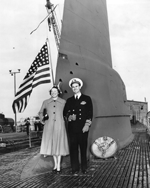 | 808k | Mrs. and LCDR W. E. Norrington (Commanding Officer) after her re-commissioning at Mare Island on 1 February 1950. | USN photo # 5337D-2-50 TH, courtesy of Darryl L. Baker. | |
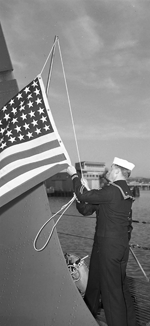 | 161k | Colors raised aboard Guavina (AOSS-362) during her commissioning at Mare Island on 1 February 1950. | USN photo # 5337F-2-50 TH, courtesy of Darryl L. Baker. | |
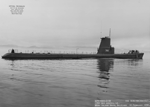 |
118k | Guavina (SSO-362) underway on 10 February 1950. | Mare Island Navy Yard Ship Files, NARA San Francisco, Photo # NY9-5399-2-50, courtesy of Tracy White @ Researcher @ Large. | |
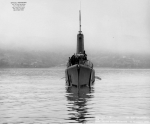 | 82k | Bow on view of Guavina (SSO-362) departing Mare Island on 10 February 1950. | USN photo # 5396-2-50, courtesy of Darryl L. Baker. | |
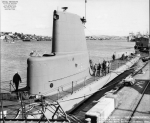 | 141k | Amidships looking aft plan view of Guavina (SSO-362) at Mare Island on 10 March 1950. | USN photo # 5660-3-50, courtesy of Darryl L. Baker. | |
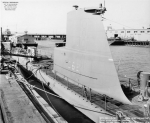 | 124k | Amidships looking forward plan view of Guavina (SSO-362) at Mare Island on 10 March 1950. | USN photo # 5661-3-50, courtesy of Darryl L. Baker. | |
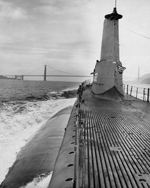 | 920k | Guavina (AOSS-362) heading for the Golden Gate on 21 March 1950. | USN photo # 5731-3-50 TH, courtesy of Darryl L. Baker. | |
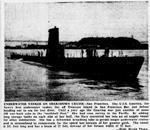 | NR | UNDERWATER TANKER ON SHAKEDOWN CRUISE The Guavina (SSO-362), the Navy's first underwater tanker, lies off Treasure Island In San Francisco Bay just before heading out to sea for test dives. Until a year ago the Guavina was just another of some 100 war-built subs in the mothball fleet. She had seen service in the Pacific. By adding long storage tanks on each side of her hull, the Navy converted her into an oil supply vessel for other submarines. She has a Schnorkel breathing tube to permit longer underwater cruises and is streamlined to compensate for the speed lost because of her greater girth. The vessel is 311 feet long and has a beam of 37 feet, instead of her former width of 27 feet. | Wide World Photo. Image and text provided by Library of Congress, Washington, DC. Photo & text by Evening Star. Evening Star. [volume] (Washington, D.C.) 1854-1972, 26 March 1950, Image 4, courtesy of chroniclingamerica.loc.gov. | |
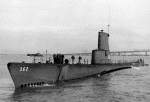 | 250k | In 1951 the submarine force achieved another important milestone. Guavina (SSO-362) used an experimental searchlight sonar to distinguish the sound signature of Seacat (SS-399) and the fleet tug Salinian (ATF-161) at ranges of 9-10 nm. | Text & USN photo courtesy of chinfo.navy.mil. | |
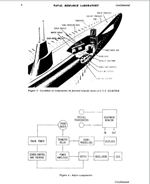 0836201 | 363k | NRL report LONG-RANGE SEARCH SONAR PART II, 15 June 1951. THE 1O-KC SYSTEM describes the installation aboard the sub with a diagram. Extract:
The transducer area i1 about 7 square feet - nearly four times that of the largest fleet searchlight transducers. To accommodate the necessary equipment, the greater part of the forward torpedo room of the Guavina (AGSS-362) was made available for the installation (the forward torpedo tubes had been removed in a previous SSO conversion). The forward torpedo room (Figure 3) is, for practical purposes, a shipboard sonar laboratory. It contains all of the long-range search system except the topside installation (also shown in Figure 3). Guavina (SSO-362) | PDF courtesy of apps.dtic.mil via Ramon Jackson. | |
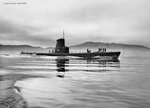 | 920k | In San Pablo Bay heading for Mare Island on 17 February 1952. | USN photo # 12018-2-52 TH, courtesy of Darryl L. Baker. | |
 | 425k | The coming and going of the Guavina (AGSS-362), Philadelphia Navy Yard, 21 July 1954. | Courtesy of John Hummel, USN (Retired). | |
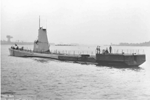 | 188k | Guavina (AGSS-362) at Philadelphia Navy Yard, 21 July 1954. | Courtesy of John Hummel, USN (Retired). | |
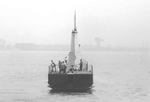 | 119k | Stern view of Guavina (AGSS-362) at Philadelphia Navy Yard, 21 July 1954. | USN photo courtesy of Scott Koen & ussnewyork.com. | |
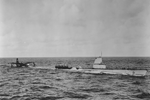 | 1.00k | Guavina (AGSS-362), refueling a P5M Marlin flying boat off Norfolk, VA. on 3 March 1955. Prior to World War II, several submarines were fitted to refuel seaplanes. During the war, Germany and Japan used this technique with some success. After the war this technique was experimented with within the US Navy. It was planned to use submarines to refuel the new jet powered P6M flying boats. As part of this program Guavina was converted to carry 160,000 gallons for aviation fuel. To do this, blisters were added to her sides and two stern torpedo tubes were removed. When the P6M project was canceled, there was no further need for submarine tankers. This concept was never used operationally in the US Navy. | Photo # 80-G-709414 scanned by Ryan Crierie, via flickr, courtesy of Stephen Gower. | |
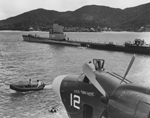 | 1.20k | Guavina (SSO-362) and Seaplane from the Tidal Wave on 3 March 1955. | Photo # 80-G-709412 scanned by Ryan Crierie, via flickr, courtesy of Stephen Gower. | |
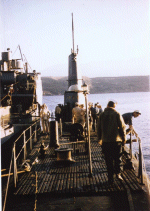 | 72k | Guavina (AGSS-362), alongside Chewaucan (AOG-50), taking on AVGAS, off Cagliari, Sardinia, 9 October 1956. | Photo by Larry Bohn. | |
 | 49k | Guavina (AGSS-362), coming alongside Chewaucan (AOG-50), to take on AVGAS, in Suda Bay, Crete, December 1956. The unusual light pattern on Guavina's hull is caused by the sun shining through the tank deck and catwalk of Chewaucan. Note the fueling platform at the stern of Guavina. | Photo by Larry Bohn. | |
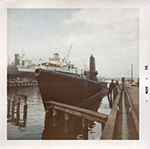 | 337k | Guavina (AOSS-362) in Baltimore, 1966. | Courtesy of Donald Wood, via submarinesailor.com. | |
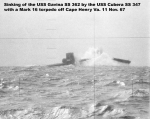 | 75k | The Guavina's (AGSS-362) final moments above the ocean floor as seen through the periscope of the Cubera (SS-347), following a Mark 16 torpedo test off the coast of Cape Henry, Virginia, 11 November 1967. | Photo courtesy of Ron Norford. | |
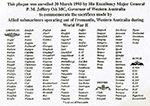 |
365k | This plaque was unveiled 20 March 1995 by His Excellency Major General P.M. Jeffery OA MC, Governor of Western Australia to commemorate the sacrifices made by Allied submarines that operated out of Fremantle, Western Australia during WW II. | Photo courtesy of Ron Reeves (of blessed memory). | |
| Back To The Main Photo Index | Back To the Submarine Index |
| Problems and site related matters, E-mail Webmaster |
| This page is created and maintained by Michael Mohl All Pages © 1996 - 2023, NavSource History All rights reserved. |